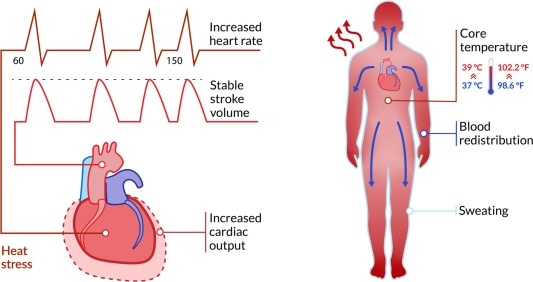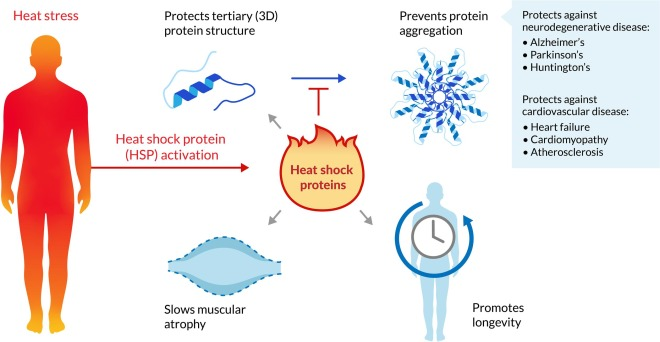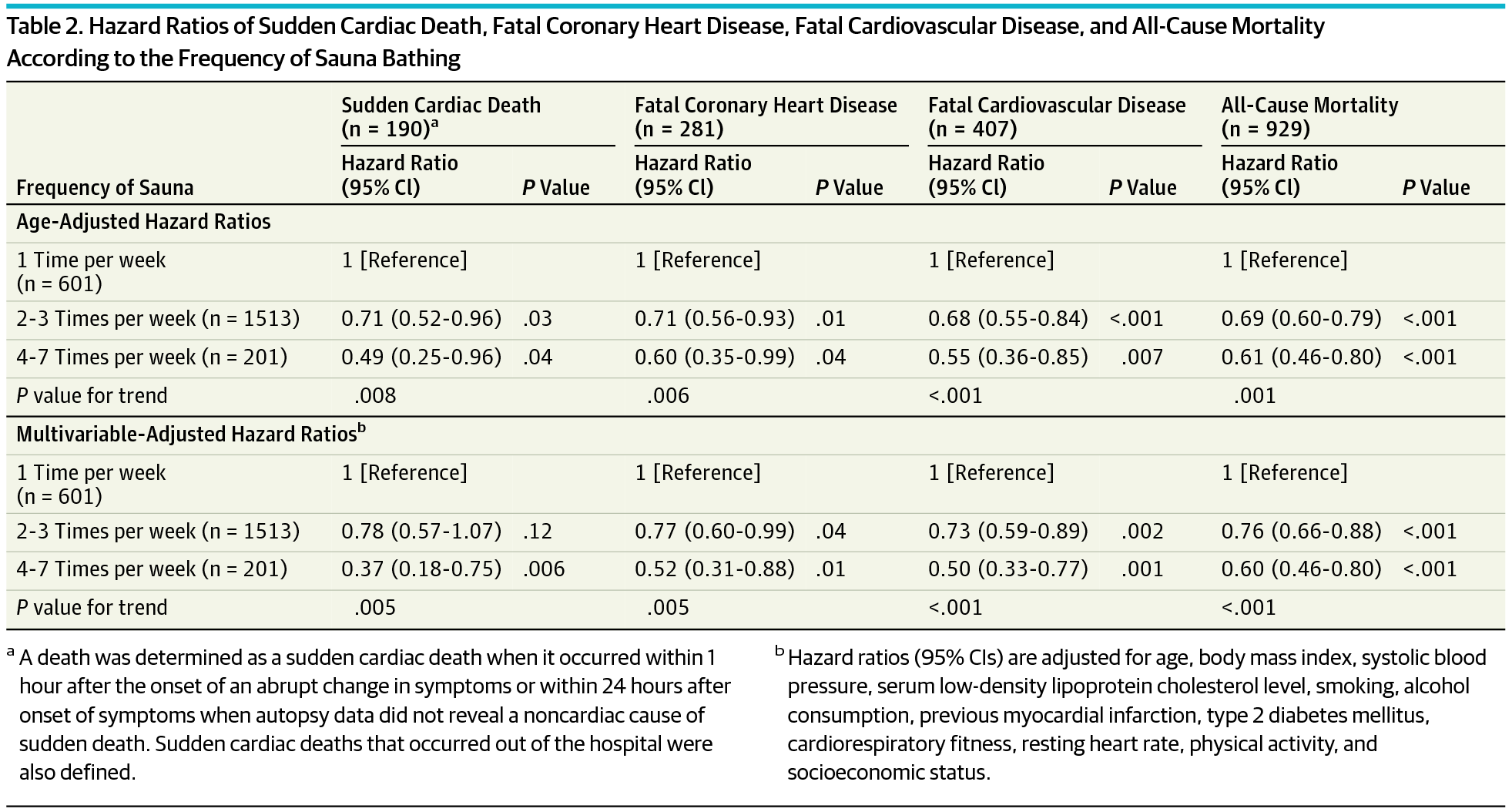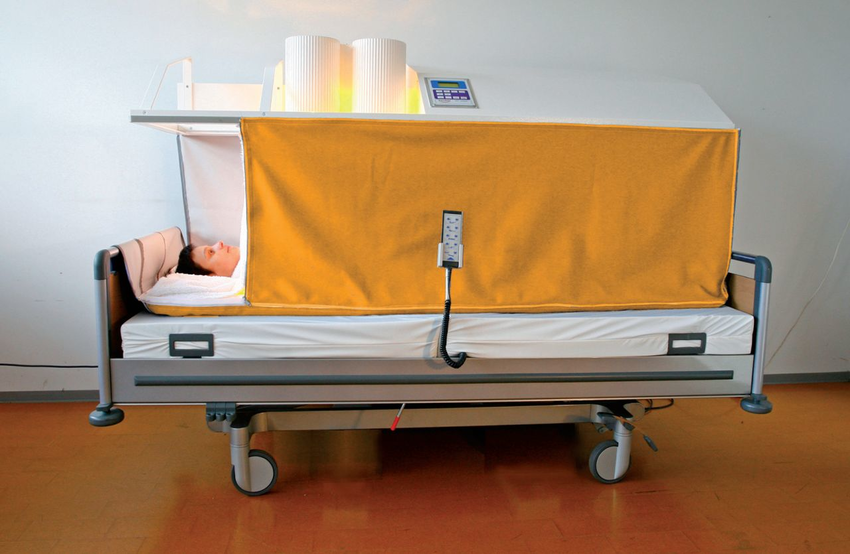🧖🏽 Why I'm Addicted To Saunas
March 20, 2022 • 21 min read
More than you'll ever want to know about saunas. An exploration of the history, science, optimal routine, health benefits, and fascinating uses of a proper sweat.
tl;dr
- Sauna use has been shown to aid in pain relief, muscle recovery, deep sleep, mental health, immune function, cardiovascular performance, chronic inflammation, and longevity.
- One study showed that (in middle-aged Finnish men) using the sauna 4-7x a week decreased all-cause mortality by a whopping 40% versus 1x a week.1
- If you want the most bang for your buck, the best effective dose of sauna usage (that has been rigorously researched) is 15-20 minutes at 180°F around 4-5 times a week — you just want to make sure you get a nice sweat going.
- You can augment sauna usage with a cold shower or cold plunge before or after to stack the benefits of cold exposure (a topic for a future post) with the benefits of heat exposure and achieve a synergistic effect.

Hi, my name is Nikhil and I'm addicted to saunas. I've been using them for years now and if I go more than a few days without a session I start to get withdrawal symptoms. My brain gets cloudy, I become irritable, and my palms sweat (and not that good sweat either).
This poses a problem since I rent a second-floor San Francisco apartment and the nearest public sauna is a 5 minute bike ride away — I end up needing to find excuses to sneak off and get a sweat on. Luckily though, I'm not the only one. A friend of mine literally built his own sauna once his local gym closed at the start of the Covid-19 pandemic. Anything for a sweet, sweaty fix…
I don't think it's necessarily "bad" to be addicted to something like saunas. A similar phenomena happens when you fall out of a good exercise groove or inhale Cheetos for dinner after a few weeks of sweet potato fries and kale chips — healthier lifestyles seem to be one-way doors as your body gets used to feeling better and starts complaining when it isn't getting what it wants.
It's my hope that this post serves to (1) enable and justify my own sauna addiction and (2) indoctrinate many other sauna addicts who swear by a good sweat. Let's get started.2
My Protocol
Before I get into the weeds, here’s what I regularly do in case you want to pull something from my practice into your own:
- 4-5x a week I spend 10-15 minutes in the sauna at my local gym (a dry sauna around 160°F) after working out.
- Every day (aspirationally) I turn my shower knob to the coldest that I can tolerate and sit in it for a minute (this feels glorious post-sauna).
- Monthly, I go to the bathhouse (Archimedes Banya) in my area to spend 2-3 hours alternating between their infrared, Finnish (dry), Russian (blazing hot at 225°F), and Turkish (steam) saunas. In between sauna sets, I sit in the freezing cold plunge for a minute, chug some electrolyte water, and chill in the pool / hot tub until I’m ready.
- If I’m feeling myself I might add some essential oils into the mix — just add a few drops of essential oil to a bottle of water and pour over the sauna coals.
The Cult of Sauna
Sauna usage is thought to date back as far as 7000 BC in Finland, a country deeply steeped in the tradition of heat bathing. The word itself means "bathhouse" in Finnish, and the country has on average one sauna per household (3 million saunas in a country with 5 million people).
Throughout the millennia, sauna usage has evolved and woven itself in cultures as diverse as primordial stone-lined dugouts in Finland, ceremonial temazcales in Mesoamerican civilization, socially integrated bathhouses in Ancient Rome, and spiritually connected Hammams in Turkey. As a common thread, these societies have used some form of heat bathing for social communion, relaxation, and physical / spiritual purification.3 In other words, saunas are Lindy.

a modern spin on a temezcal
Even today, as I visit modern-day spas and bathhouses like the legendary Archimedes Banya in San Francisco, I see the kinship brought about by shared perspiration. Over the centuries, the rationale for sauna usage has shifted from spiritual purification to the overall health benefits uncovered by a rich literature of medical studies, but the subjective human experience of a proper soak has remained the same.
What happens when you step into a Sauna?
The best way to discover the effects of stepping into a sauna is to… well… step into one. However, your first sauna session can be quite intense and you may find yourself lethargic and mentally foggy (at least until you step out and cool down). So here, let me briefly4 go over what's happening:
- (0 min) As your body is exposed to high temperatures (typically around 180°F), there's a rapid response on your skin and cardiovascular system, and your skin heats to about 104°F, and your core body temperature (from 98.6°F) increases to 102°F.
Knees get weak, palms sweaty, vomit on your sweater already, mom's spaghetti.- (1 min) The work output of your heart increases (more blood gets pumped), and your heart rate itself starts to increase.
- (5 min) Most of your blood circulation redistributes to your skin to facilitate sweating — you can start losing up to a kilogram of liquid per hour at this rate.
- (~10 min) The hormetic response (your body's natural response to stress) increases the expression of heat-shock proteins (HSPs — more on these bad boys below) to aid in cell & protein repair, and increase mitochondria (the powerhouse of the cell e.g. energy).
- (10-15 min) The pool of sweat you're sitting in along with your own unmistakable odor becomes unbearable and you leave the sauna, heart pounding as if you'd just gone for a run.
- (post-sauna) Shortly after, you're likely to feel a bit of euphoria from the endorphins and other lovely neurotransmitters released after a healthy sweat.

WTF are heat-shock proteins (HSPs)?
Okay, so I've mentioned the release of HSPs as a benefit of heat exposure but what do they actually do? The release of these proteins is even touted in hot yoga as one of the benefits associated with stretching while sweating buckets, but few yoga studios explain how they actually improve your health.
To explain this, we'll need to step back a little bit to understand proteins and their purpose within your body. Proteins are the most dynamic molecules in your body and help replicate DNA, provide cell structure, and transport molecules. The function of any given protein is determined by its composition (what amino acids it's made out of) and how it's folded (the net result of complex inter-molecular atomic interactions).
The important bit to understand is that the way a protein is folded is crucial for determining its use within the host organism. Over time, some proteins misfold as a result of genetic mutations, environmental stress, or just plain old entropic decay. These misfolds are theorized to be a primary driver of aging and disease5 in living organisms.
That brings us to HSPs, which are a type of protein generated by cells during stressful conditions — they were initially observed during heat shock (hence the name), but are now shown to be released during other physical stresses like cold exposure, UV exposure, and wound healing.
The magic of HSPs is that they fix other proteins that are misfolded.
That's right, they directly ensure that other proteins fold properly, refold damaged ones, and even help recycle dead proteins.

HSPs are part of the body's natural response to stress and are like good samaritans that clean up when things get stressful6. Like the autophagy process which occurs during a fast, the release of HSPs is crucial to keeping things clean and well-regulated.
Health Benefits of Sauna Usage
This section is the meat & potatoes of this post, and for this important topic, I am leaning very heavily on this incredibly thorough review by Dr. Rhonda Patrick of the scientific literature behind sauna usage as a practice to extend healthspan (the amount of years that one stays healthy). I'll include references and links to parts of the review at the end of each section if you'd like to dive further into the research.
Longevity
A regular sauna practice reduces your risk for heart disease, dementia / alzheimer's, and various other illnesses, decreasing your chance of death at any given time. Sauna use is known to have powerful longevity benefits, and this reduction in "all-cause mortality" is why.
According to this 2015 study from Finland, the incidence of all-cause mortality was 40% lower in the experimental group that used the sauna 4-7 times a week, versus another one that only used it once a week.

Fitness & Muscular Recovery
As we age and deteriorate, our strength and muscles tend to atrophy. Without regular resistance training, it can be hard to fend off this natural process (thanks entropy) caused by decreased protein synthesis and protein degradation.
Heat exposure through sauna usage can slow down this natural process of protein degradation through the increased expression of HSPs and the release of growth hormone, which is important in muscle growth & recovery.
In addition, saunas are physiologically similar to moderate-intensity exercise. If you spend enough time in one, your heart rate will rise and you’ll sweat a ton — and all you have to do is sit in a hot room and deal with it. The benefits of this are similar to those that come with regular exercise, including better cardiovascular endurance, oxygen efficiency, and thermoregulatory (your ability to heat / cool yourself) function. These attributes all make for better performance while playing sports, doing other physically strenuous stuff, or even just living day-to-day.
Sleep
Sleep is a general-purpose tool for improving our health, as it's a fundamental building block for our wellbeing. Therefore, anything that can improve the quality of our sleep is something that will have cascading effects on our health. I couldn't find too much quantitative data on the benefits of sauna bathing to sleep quality by well-established metrics (time in deep / REM sleep, HRV, resting heart rate, etc.) but I did find a study in a review that indicated that regular sauna bathing had a significant impact in overall sleep hours in police officers that were exposed to toxic drugs (5.8h vs. 7.6 h, p < 0.001).
Anecdotally, I've found that I sleep better overall (measured by my Oura ring) after hitting the sauna that day. One of the primary improved vectors for me is increased deep sleep (around 15-20m more) along with a faster onset of sleep — this is consistent with my experience of sleeping better if I had exercised that day. My HRV (a good metric to measure recovery) also increases by 10-15% and is likely due to the effect that sauna usage has on modulating the autonomic nervous system.
Mental Health
Beyond the cognitive and mental benefits of releasing HSPs, sauna usage (similar to exercise) increases BDNF (known as "miracle grow” for the brain) which promotes the growth of new neurons. Sauna usage also encourages blood flow to the brain and nervous system, helping keep our neural piping well lubricated. Some combination of these goodies is what's been shown to reduce the development of neurodegenerative diseases (Alzheimer's, Dementia, etc.) by 65%.
Other than neurodegenerative disease, sauna use has also been shown to improve symptoms of depression, likely due to its systemic effect on decreasing inflammation (which is heavily linked to depression). The release of endorphins and endogenous opioids (also released during exercise) might also have a role to play in this phenomena. See this section for a promising alternative to SSRIs by using whole-body hyperthermia (sauna tent) to treat depression.
Beyond the physiological effects of sauna are the social benefits that stack more goodness onto the overall experience. The beauty is that you have a choice of using a session for solo meditation / self-exploration or as an opportunity to revel with other sweaty, naked humans.
see section 4.3
Inflammation
Acute inflammation in response to a stressor is natural and helpful towards kickstarting the healing and recovery processes in your body. However, chronic low-grade inflammation is terrible and wears the body down. Therefore, it’s important to keep chronic inflammation down while not interfering with acute inflammatory responses.
Sauna bathing (like exercise) provokes an acute inflammatory response (a release of pro-inflammatory cytokine IL-6) in response to the increased core body temperature and cardiovascular load. This in turn leads to a counter response in the body which releases anti-inflammatory cytokines (IL-10 and IL-1ra) to reduce chronic systemic inflammation.
It’s pretty counterintuitive, but by intentionally provoking an acute inflammatory response, you are reducing systemic chronic inflammation.
In addition, it’s been shown that regular sauna bathing leads to a lower level of C-reactive protein (CRP) which is the gold standard for measuring systemic inflammation in the body.
Immune Function
HSPs help with many protective immunological functions like signaling to the body that there are foreign microorganisms present and helping to rally the natural immune response. It’s likely these roles (among other, undiscovered phenomena) that leads us to see the following compelling data related to sauna use:
- 41% decreased risk of developing pneumonia among men using sauna 4-7 a week versus < 1 times a week
- Improvements in respiratory function for people with obstructive pulmonary disease (an immunological disease)
- Increased white blood cell count, lymphocytes, neutrophils, and basophils immediately following (all useful when the body is mounting an immune response)
The argument could thus be made that sauna bathing while you’re sick could improve your recovery time and decrease symptoms. However I would strongly suggest against going into a public sauna while you’re sick, to prevent spreading germs. If you have access to a private sauna, I think it’s worth a try (after clearing it with your doctor, of course).
see section 4.6
Pain Relief
Saunas offer a promising route towards natural strategies for pain relief by increasing blood circulation & oxygen flow, and reducing soreness on nerve endings. There's also an endorphin release following sauna exposure, which is known to reduce both chronic and acute pain, if only temporarily.
The research literature also shows promising evidence that sauna usage can help those suffering from fibromyalgia, peripheral arterial disease, and rheumatoid arthritis deal with the painful symptoms of these diseases.
Practical Real-World Usage of Sauna
During my research, I found many real-world use-cases for saunas that have a directed purpose beyond general health and wellbeing. Unfortunately, most of these aren't too well studied yet so we don't have clear data as to whether sauna use is for sure good for each particular use-case. Regardless, it's a useful exploration of the range of problems that something as simple as perspiration can solve.
Heavy Metal "Detoxification"
During the crypto summer of 2021, I went to a local event for developers and enthusiasts. I met an interesting guy towards the beginning, and between his theories on recent Dogecoin spikes, he let it slip that he was a part-time firefighter. I asked him about the implications of being a firefighter in South California, where the fire season has been rough over the past few years. He mentioned that they built pop-up saunas at the fire sites so that the firefighters could detox, which piqued my interest.
The word "detox" is typically a signal that whatever you're looking at is new-age pseudoscience. Saunas are great even without the connotation of being an otherworldly tool to rid you of bad juju (for $99.99) — however, it made sense to me that one of the body's natural mechanisms for releasing liquid from the body (sweating) could expel stuff other than water and salt, so I dug deeper. From a statement put out by the International Association of Fire Fighters (IAFF):
… A recent review summarized 24 articles that examined metal levels in sweat. The authors concluded that excretion of metals through sweat could match or exceed that through urine …
… However, although the authors conclude that sweating should receive additional consideration for toxic element detoxification, they noted that much of the data they reviewed was old and that research was needed to establish safe, effective therapeutic protocols.
Due to the limited literature on sauna usage for detoxification of toxic elements, the IAFF decided to recommend against its use after fire suppression activities, even though it has promising potential.
This is the unfortunate reality when considering implementing new health interventions. If there isn't a truly compelling case to be made, it's better to err against adding new protocols. I think that this needs to be studied more rigorously to implement strategies for firefighters to actually detoxify. Firefighters have a significantly higher risk for cancer, and any tool that can help alleviate this affliction should be explored.
Cardio for those with Limited Mobility
Heat exposure is biologically similar to cardiovascular exercise. The same protective responses are triggered as the heart works faster to pump blood throughout the body, sometimes surpassing even 150 bpm during particularly intense sessions.
The best part? All you need to do is sit in a hot room for 10-15 minutes and ignore the discomfort. This is a godsend for those with disabilities that limit mobility and essentially rule out healthy and vigorous exercise. From a paper by Europe PubMed Central:
For sedentary populations, such as people with a disability, wheelchair users, or the elderly, the prevalence of chronic low-grade inflammation- related disease is further increased above that of individuals with a greater capacity to be physically active.
Performing regular exercise with its proposed anti-inflammatory potential may not be feasible for these individuals due to a low physical capacity or other barriers to exercise. Therefore, alternatives to exercise that induce a transient acute inflammatory response may benefit their health.
… Manipulating body temperature may be such an alternative. Indeed, exercising in the heat results in a larger acute increase in inflammatory markers such as interleukin-6 and heat shock protein 72 when compared with exercising in thermoneutral conditions. Moreover, similar to exercise, passive elevation of body temperature can induce acute increases and chronic reductions in inflammatory markers and positively affect markers of glycemic control.
(emphasis mine)
Better than SSRIs for Depression?
I knew from my own experience that saunas have tangible mental health benefits, but after listening to this podcast with Dr. Rhonda Patrick and Dr. Ashley Mason, I found out that a variation of heat exposure in the form of whole-body hyperthermia (WBH) has the potential to be a treatment for depression. WBH is basically just lying down in a heated sauna dome with your head sticking out for up to an hour.

It's not clear (without more research) why this works, but theories include a decrease in inflammation (a common comorbidity of people with depression), a mechanism to connect socially, and the simple fact that sauna usage helps regulate your ability to sweat.
The study mentioned in this podcast will measure HSPs, markers of inflammation, and the subject's reported score of depression and compare the results of (WBH) to that of cognitive behavioral therapy — the gold standard for non-drug treatment of depression. Early results have shown that a single session of WBH decreases subjective scores of depression and keeps them lower for over six weeks.
Misc. Things to Consider
Over the years, multiple modalities to tap into our hardwired ability to sweat have emerged. Here are a few of the common ones:
- The dry sauna is the oldest and where the lion's share of research emerges from. The humidity in a dry sauna is < 20% and is powered by hot coals. The temperature generally ranges from 160-200ºF, with the optimal time inside being 10-20 min, depending on the temperature.
- The wet sauna (also known as a steam room) is much more… wet, with a humidity > 50%. The wet sauna might be cooler but paradoxically feels warmer because our bodies cannot cool themselves via evaporation, so we end up having a stronger cardiovascular response.
- There’s also a relatively new kid on the block, the infrared sauna. Instead of heating the body via air on the skin, an infrared sauna uses infrared light to heat the body from within, cooking you from the inside out. This sounds crazy, but works surprisingly well.
Outside of sauna usage, there are other heat stress tools you can use to elevate core body temperature like heated blankets, hot baths, specialized infrared lamps, or even hot yoga. All of these have been shown to improve cardiac health, release HSPs, and improve mental health.
To stack health benefits, you can layer on cold exposure to your sauna practice. This can involve an ice bath, cold shower, or a cold plunge. Cold exposure can augment the sauna’s benefits of reducing chronic inflammation, helping with muscular recovery and soreness, improving blood flow, along with its own range of benefits. I’ll hopefully expand on the benefits of the cold in a future post, but for now know that the minimum viable dose will be to stay in the cold until you’re shivering.
A post on the benefits of sauna usage cannot be complete without the risks. As a disclaimer I must say that you should talk to your doctor and understand any existing contraindications7 you might have before committing yourself to a physically strenuous activity like regular sauna usage. Some of the risks:
- Dehydration: This one is obvious. You sweat a lot in a sauna, and thus it's important to hydrate before & after. After a heavy day of heat stress (maybe at a bathhouse) it would be good to re-up your electrolytes as your body tends to sweat out salts very quickly.
- Male Fertility: Heat exposure has been shown to have significant (but not permanent) effects on male sperm and fertility. Notable results from this study include the fact that there was no hormonal change, and that fertility returned to normal within 6 months of not using the sauna.
- Special Populations: As is the case with most hormetic health interventions, pregnant women and children are generally exempt from the benefits, and might even suffer consequences from sauna usage.
Conclusion
Big thanks to Dr. Rhonda Patrick for beating the drum of sauna usage into my skull and getting me addicted, and also for providing a lot of the scientific source material and diagrams referenced in this post. Thanks also to Mack, Parth, Tyler, and Anthony for looking at drafts of this post. And of course, thanks to all the lovely people I've shared a sweat with over the years.
That's it for now. Many of my friends know that I never shut up about saunas, and now you know that as well. Let me know what you thought of this post, and especially let me know if you've decided to incorporate a regular sauna practice into your life. Tweet at me or shoot me an email. Stay sweaty, my friends! ✌🏾
Footnotes
-
In isolation, it’s difficult to extrapolate these results with scientific integrity to the average reader who never saunas, since the study compares those that sauna 1x a week to those that sauna 4-7x a week. However, when augmenting these results with the rest of the literature around saunas, I think it’s safe to conclude that at least some of these benefits from 4-7x sauna sessions a week would apply to those that don’t regularly sauna. ↩
-
This should go without saying, but I'm using the term addiction in a very tongue-in-cheek way. I am in no way minimizing clinical addiction, and if you are truly addicted to something (be it saunas or otherwise), please seek psychological help. Disclaimer over. ↩
-
A great resource for learning about the history of saunas can be found on the Archimedes Banya blog. ↩
-
References to all of the quantified metrics related to your body's response to heat stress can be found here. ↩
-
As an example, Prion diseases (e.g. Mad Cow Disease) are rare neurodegenerative diseases that are known to be caused by a cascade of misfolded proteins in the brain. ↩
-
HSPs are naturally over-expressed in Alzheimer’s patients that don’t use the sauna and have been shown to actively protect against the early stages of amyloid-beta (brain plaque found in Alzheimer’s patients) formation, which suggests that the body naturally recruits HSPs even in the absence of heat to mitigate protein misfolding. ↩
-
A contraindication is “a specific situation in which a drug, procedure, or surgery should not be used because it may be harmful to the person” according to Medline, or rather something that might have a negative synergistic effect e.g. if you have a specific heart condition and also hit the sauna regularly. ↩
